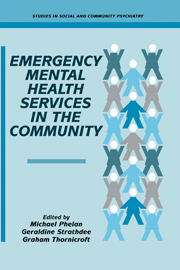Book contents
- Frontmatter
- Contents
- Contributors
- Foreword
- PRINCIPLES AND POLICIES
- CHALLENGE OF IMPLEMENTATION
- 9 Establishing a local emergency service
- 10 Maintaining an emergency service
- 11 Psychiatric emergencies in the casualty department
- 12 Acute crisis respite care
- 13 Family placement schemes as an alternative to short-term hospitalisation
- 14 Acute home-based care and community psychiatry
- 15 Acute day hospital care
- 16 Acute in-patient wards
- 17 The future of mental health emergency services
- Index
9 - Establishing a local emergency service
from CHALLENGE OF IMPLEMENTATION
Published online by Cambridge University Press: 28 October 2009
- Frontmatter
- Contents
- Contributors
- Foreword
- PRINCIPLES AND POLICIES
- CHALLENGE OF IMPLEMENTATION
- 9 Establishing a local emergency service
- 10 Maintaining an emergency service
- 11 Psychiatric emergencies in the casualty department
- 12 Acute crisis respite care
- 13 Family placement schemes as an alternative to short-term hospitalisation
- 14 Acute home-based care and community psychiatry
- 15 Acute day hospital care
- 16 Acute in-patient wards
- 17 The future of mental health emergency services
- Index
Summary
Introduction
This book covers a wide range of different approaches to providing emergency mental health care, and describes specific approaches that have worked in different settings. In this chapter, the focus will be on the major issues facing anyone who has the responsibility of establishing a community-based emergency mental health service for a specific geographical area. The emphasis is on the strategic planning which is vital for the development of an effective and comprehensive service.
We have approached the task from the perspective of clinicians and managers involved in the development of a comprehensive community mental health service, of which an emergency service forms an integral component. The resources and facilities of mental health services are all too often dependent on historical and haphazard planning, and are therefore unresponsive to the current needs of the local population. For example, emergency services have been centred around hospital bases even when these are inaccessible or unsuitable. Emergency services are often considered in terms of the specific facilities that are available or planned. As different facilities can fulfil the same functions, it is a useful exercise to explore the numerous functions that a service can be expected to fulfil, before deciding on specific service components. The rational first step in developing any service is to collect information so that your service can be tailored to local need.
- Type
- Chapter
- Information
- Emergency Mental Health Services in the Community , pp. 177 - 196Publisher: Cambridge University PressPrint publication year: 1995
- 1
- Cited by



